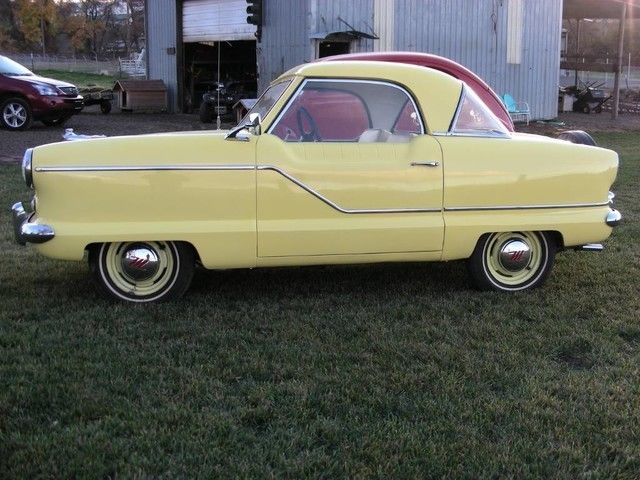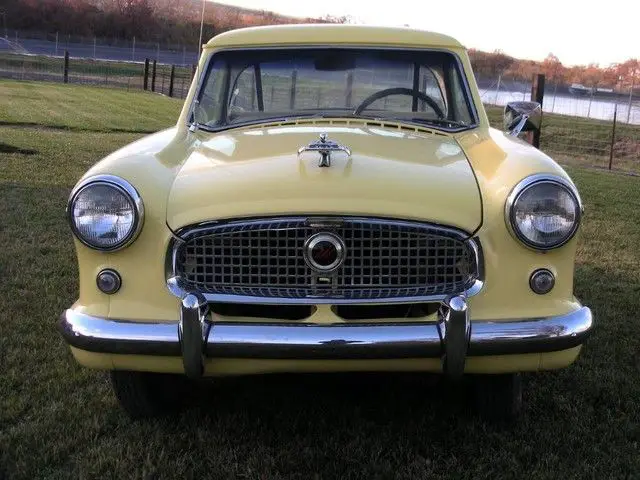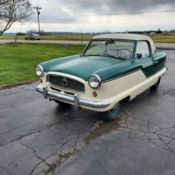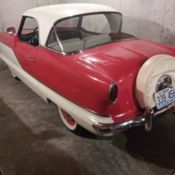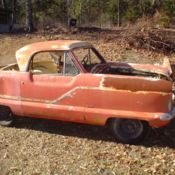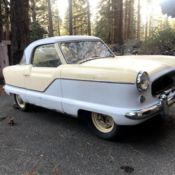1958 Nash Metropolitan 2 Dr Coupe
| Condition: | Used |
| Make: | Nash |
| Type: | Coupe |
| Doors: | 2 |
| Year: | 1958 |
| Mileage: | 71313 |
| VIN: | F-42522 |
| Color: | Yellow |
| Engine: | 4 |
| Fuel: | Gas |
| Transmission: | Manual |
| Drivetrain: | Rear Wheel Drive |
| Interior color: | Tan |
| Vehicle Title: | Clear |
| Item location: | College Place, Washington, United States |
| Extras |
| Listed by | Private seller |
Description of 1958 Nash |
|
1958 Nash Metropolitan 2 DR AUTOCHOICE Is Yours Dot Com, LLC is proud to list for your pleasure to purchase a rare 1958 Hudson Nash Metropolitan 2 dr coupe. On consignment this car has been in the same family on and off for the past 30 years. Drives great and looks awesome. This car originally came in a two tone White and Yellow as the paint code shows, but the present owner wanted something different and he got it. This car make for a good show car at your local car shows and driven on those special weekends. You will certainly get heads turning your way. For further questions, you are welcome to call Don at (509) 301-1498, (voice/Text). NOTE: Correction on the serial (VIN) number, it is a E not F, E42522For those that find the Metropolitan to be your first introduction here, we have included a Wikipedia report right here for your please and education: Nash Metropolitan From Wikipedia, the free encyclopedia Jump to navigationJump to search Metropolitan 1957 Metropolitan Overview Manufacturer Austin(BMC) Alsocalled HudsonMetropolitanMetropolitan byAmerican MotorsAustin Metropolitan Production October 1953–April 1961(1954–1962 model years) Assembly Longbridge,Birmingham,West Midlands, England Designer William J. Flajole Body and chassis Class Economy carSubcompact car Bodystyle 2-doorhardtop2-doorconvertible Layout FR layout Powertrain Engine 1,200cc(1.2L)AustinA40I41,200cc (1.2L)B-SeriesI41,500cc (1.5L)B-SeriesI4 Transmission 3-speedmanual Dimensions Wheelbase 85in (2,159mm) Length 149.5in (3,797mm)[1] Width 61.5in (1,562mm) Height 54.5in (1,384mm)[2] Curbweight 1,785lb (810kg) (base)TheNash Metropolitanwas anAmericanautomobilethat was sold from 1953 to 1961. It conforms to two classes of vehicle:economy car[3]andsubcompact car.[4][5][6][7][8]In today’s terminology the Metropolitan is a “subcompact”, but this category had not yet come into use when the car was made.[9]At that time, it was variously categorized, for example as a "small automobile" as well as an "economy car". The Metropolitan was also sold as aHudsonwhenNashandHudsonmerged in 1954 to form theAmerican Motors Corporation(AMC), and later as a standalonemarqueduring theRambleryears, as well as in the United Kingdom and other markets. 1957 Hudson badged Metropolitan 1961 Metropolitan fender emblem Contents 1Design 2First reviews 3Production for U.S. 3.1Series I 3.2Series II 3.3Series III 3.4Series IV 3.5Yearly shipments 3.6Production dates 4Production for foreign markets 5Epilogue 6Police market 7Astra-Gnome 8Metropolitan Club (AMC) 9Collectibility 10Notable owners 11Notes 12References 13External links Design[edit]While most U.S. automobile makers were following a "bigger-is-better" philosophy,Nash Motor Companyexecutives were examining the market to offer American buyers an economical transportation alternative. The Metropolitan was designed in the U.S. and it was patterned from aconcept car, theNXI(Nash Experimental International), that was built byDetroit-based independent designer William J. Flajole forNash-Kelvinator.[10]It was designed as thesecond car in a two car family, for Mom taking the kids to school or shopping or for Dad to drive to the railroad station to ride to work:[11]the "commuter/shopping car" with resemblance to the big Nash, but the scale was tiny as the Met's wheelbase was shorter than theVolkswagen Beetle's.[12] The NXI design study incorporated many innovative features, and attempted to make use of interchangeable front and rear components (the symmetrical door skins were the only interchangeable items that made it into production). Although more complex, the new vehicle also incorporated Nash's advanced single-unit (unit body) construction. It was displayed at a number of "surviews" (survey/previews), commencing on 4 January 1950 at the Waldorf-Astoria Hotel, New York, to gauge the reaction of the American motoring public to a car of this size. The result of these surviews convincedNashthat there was indeed a market for such a car, if it could be built at a competitive price. A series ofprototypesfollowed that incorporated many of the improvements from the "surviews" that included roll-up glass side windows, a more powerful engine, and a column-mounted transmission shifter with bench seat (rather than bucket-type seats with floor shift fitted in the concept car). The model was namedNKI(for Nash-Kelvinator International), and it featured revised styling incorporating a hood blister and rear wheel cutouts.[10] Nash was positioning this new product for the emerging postwar market for "personal use" autos.[13]These specific use vehicles were as a second car for women or an economical commuter car.[13]The Metropolitan was also aimed at returning Nash to overseas markets. However, Mason and Nash management calculated that it would not be viable to build such a car from scratch in the U.S. because the tooling costs would have been prohibitive. The only cost-effective option was to build overseas using existing mechanical components (engine, transmission, rear end, suspension, brakes, electrical), leaving only the tooling cost for body panels and other unique components. With this in mind, Nash Motors negotiated with several European companies. On October 5, 1952, they announced that they had selected theAustin Motor Company(by then part ofBMC) andFisher & Ludlow(which also became part of BMC in September 1953, later operating under the name Pressed Steel Fisher), both English companies based inBirmingham, Englandand vicinity. Fisher & Ludlow would produce the bodywork, while the mechanicals would be provided, as well as final assembly undertaken, by the Austin Motor Company. This was the first time an American-designed car, to be exclusively marketed in North America, had been entirely built inEurope. It became acaptive import– a foreign-built vehicle sold and serviced by Nash (and later by American Motors) through its dealer distribution system. It is believed that the first pre-production prototype was completed by Austin on December 2, 1952. In all, five pre-production prototypes were built by Austin Motors and tested prior to the start of production. The total tooling cost amounted to US$1,018,475.94, (Austin: US$197,849.14; Fisher & Ludlow: US$820,626.80) which was a fraction of the tooling cost for a totally U.S.-built vehicle. The styling for all Nash vehicles at that time was an amalgam of designs fromPinin Farina and his design houseof Italy and the in-house Nash design team. The different models from Ambassador down to the Metropolitan utilised very similar design features (fully enclosed front wheels, notched "pillow" style door pressing, bar style grille etc.). Whilst Nash used the fact that styling was by Pinin Farina in their advertising for their larger models, Farina refused to allow his name to be associated with the Metropolitan as he felt it would damage his reputation with other Italian car companies to be linked to such a small car. The new Metropolitan was made in two body designs: convertible and hardtop. All came with several standard features that were optional on most cars of the era. Among these factory-installed benefits for customers were a map light, electric windshield wipers, cigar lighter, and even a "continental-type" rear-mounted spare tire with cover. To give a "luxury" image to the interior, "Bedford cord" upholstery trimmed with leather was used (similar to larger Nash vehicles). AnAMradio, "Weather Eye" heater, andwhitewall tireswere offered as optional extras for the U.S. market. (It is unlikely that a Metropolitan could have been purchased without a heater and radio, as all vehicles left the factory with both items fitted.) The Metropolitan was the first postwar American car that was marketed specifically to women.[14]TheDodge La Femmewas introduced one year later. The first spokesperson for the car was Miss America 1954,Evelyn Ay Sempier, and the car was prominently advertised inWomen's Wear Daily.[14]American Motors' marketing brochures described the new model as "America's entirely new kind of car" (1955), "Luxury in Miniature" (1959), and "crafted for personal transportation" (1960).[15] First reviews[edit]Initial reviews of the Metropolitan were mixed. However, owners of the cars reported that the "Metropolitan is a good thing in a small package".[16] Automotive industry veteran and the largest publisher ofautomotive booksat the time,Floyd Clymer, took several Metropolitans through his tests. He "abused" a 1954 Metropolitan convertible and "got the surprise of my life" with its "performance was far better than I expected", that he "felt very safe in the car", and that "it may well be that Nash has started a new trend in American motoring. Perhaps the public is now getting ready to accept a small car".[17]Clymer also took a 1957 Metropolitan hardtop through a grueling 2,912mi (4,686km) road test that even took him 14,100ft (4,300m) upPikes Peak. He summed up his experience that "I can not praise the Metropolitan too highly. It is a fascinating little car to drive, its performance is far better than one would expect, and the ride is likewise more than expected".[18] According toCollectible Automagazine, the car was described inCar Life's review as "a big car in miniature" that was "fun to drive" and "ideal for a second car in the family,"[19]whileMotor Trendwas not alone in regarding the rear "utility" seat as "a joke."[20] Motor Trendpraised the car’s economy: their test Metropolitan returned: 39.4mpgUS(5.97L/100km; 47.3mpgimp) at 45mph (72km/h), 27.4mpgUS(8.6L/100km; 32.9mpgimp) at 60mph (97km/h), and 30.1mpgUS(7.8L/100km; 36.1mpgimp) "in traffic."[21]Mechanix IllustratededitorTom McCahillwrote: “It is not a sports car by the weirdest torturing of the imagination but it is a fleet, sporty little bucket which should prove just what the doctor ordered for a second car, to be used either for a trip to the movies or for a fast run to a penicillin festival.”[22]He added that it was a “nice-handling car with plenty of control and amazing dig, considering it is powered by a small Austin A-40 engine” and that the finish was “very nice”, although having no trunk opening except by pulling down the back of the rear seat “poses a problem.”[22]His test car accelerated from0 to 60 mphin 19.3seconds and could exceed 70mph (110km/h). ARoad & Trackroad test recorded acceleration from 0–60mph in 22.4seconds, "almost half of the VW’s 39.2." However the magazine noted that at 60mph (97km/h), a common American cruising speed at the time, the Metropolitan was revving at 4300 rpm, which shortened engine life, whereas the Volkswagen could travel at the same speed at only 3000 rpm.[23]Road & Track's testers also said that the car had “more than its share of roll and wallow on corners” and there was “little seat-of-the-pants security when the rear end takes its time getting back in line.”[19] Road Testmagazine said in 1954 that "on roadability and responsive handling, the Met shines. It also offers easy maintenance and downright stinginess when it comes to gasoline consumption. Also, it's literally a brute for punishment. On several occasions I took familiar corners at speeds half again what I would dare to use in some cars of twice the weight– proof that proper weight distribution, low center of gravity and well engineered suspension have more to do with roadability than massiveness, weight and long wheelbases. Admittedly, the short wheelbased Met does pitch moderately on very rough roads, but the sensitivity and ease of steering make driving a pleasure."[24] Production for U.S.[edit] Series I[edit] Series I Overview Production 1953 Nash dealership with a Metropolitan visible, 1954Production at Austin'sLongbridgefactory started in October 1953 (CommencingVINE1001). Nicknamed the "baby Nash", the cars were tiny. They had an 85in (2,159mm) wheelbase, overall length of 149.5in (3,797mm) and a gross weight of only 1,785lb (810kg) for the Convertible and 1,825lb (828kg) for the Hardtop, thus making the Metropolitan smaller than theVolkswagen Beetle. The two models, a convertible and a hardtop, were powered by theOHV1,200cc (73cuin)straight-4Austin 'A40' series engine (as used in theAustin A40 Devon/Dorset)driving the rear wheelsthrough a three-speedmanual transmission. The initial order was for 10,000 units, with an option to increase the order if sales were sufficient. The new model was initially to be called the "NKI Custom", but the name was changed to "Metropolitan" just two months before its public release. New chrome nameplates with the "Metropolitan" name were made to fit into the same holes as the "NKI Custom" script on the passenger side front fender. Nashdealershad to rebadge the early cars that came with the "NKI Custom" name, but some factory manuals had already been prepared and distributed to service departments with the NKI name.[10]The first examples badged as Nash went on sale on March 19, 1954 in the U.S. and Canada.Autocarsaid that "at a production rate of less than 400 cars a week... it was hardly going to be a runaway best seller."[25] In surveys, Americans had affirmed a desire for economy cars, but in practice they bought the Metropolitan in relatively small numbers. Although Nash merged with Hudson in 1954, and marketed the car as a Hudson Metropolitan in 1955, "demand never took off from the original level", primarily because the Metropolitan was slow by North American standards.[25]In the first month of sales, 862 Metropolitans were sold in U.S. and Canada, while in the first six months a total of 7,042 were sold. A further order was placed with Austin. Available exterior colors were P903 "Spruce Green", P904 "Canyon Red", P905 "Caribbean Blue", or P906 "Croton Green", with P907 "Mist Grey" as a contrast color for the hardtops. P906 "Croton Green" was dropped as a color option in April 1954. Cars incorporated the Nash logo on their grille badge, hubcaps, horn button, and spare wheel cover. Thesuggested retail price(MSRP) for Series I (also known as NK1) models wasUS$1,445 (Hardtop) and $1,469 (Convertible). Adding a radio and a heater pushed the price above $1,500: at the timeVolkswagen's Bug/Beetlewas being offered at $1,425.[26] In May 1954,Nash-Kelvinator Corporationannounced that it had merged with theHudson Motor Companyto formAmerican Motors Corporation(AMC). Thus by August 1954, Metropolitans also became available from Hudson dealers. These Hudson Metropolitans carried a Hudsongrillebadge,hubcapsincorporating an "M" logo, a "bulls-eye" horn button design, and a plain spare wheel cover. Braking performance was 90ft (27.4m) from 45 miles per hour (72km/h) to a full stop.[27] In 1954, George Mason took two Metropolitans to Raleigh Speedway in North Carolina for some tests. The first Metropolitan did a 24-hour endurance run, going a total of 1,469.7 miles (2,365km) without the need for a tune up, while the second car was put to a 24-hour fuel economy run.[27]It averaged 41.7mpgUS(5.64L/100km; 50.1mpgimp).[27] Series II[edit] Series II Overview Production 1955After the first 10,000 cars were built, the engine was changed to aB-Series, but still of 1,200cc (73cuin), (as used in theAustin A40 Cambridge). Other modifications that were incorporated at this time were a new gearbox, and hydraulic actuation for the clutch (Series I models used a mechanical clutch linkage). The change to a new engine and gearbox added 50lb (23kg) to the weight. This model is referred to as Series II or NK2 (Commencing withVehicle identification number(VIN) E11001 on August 19, 1954). Series III[edit] Series III Overview Production 1955–58 Series 3 1500 engineNovember 1955 saw the start of Metropolitan Series III (NK3) production (Commencing with VIN E21008 on 28 November 1955). A redesign at this time saw the Metropolitan'sB-Seriesengine increased in capacity to 1,498cc (91.4cuin) (as used in theAustin A50 Cambridge). Polishedstainless steelsweep-spears on the body sides allowed a new two-tone finish to be incorporated, which had the cosmetic effect of lowering, slimming and lengthening the car. The new exterior colors were P905 "Caribbean Green", P910 "Sunburst Yellow", and P911 "Coral Red" with P909 "Snowberry White" as a contrast. The grille was also redesigned, and the hood had its non-functionalhood scoopremoved. American Motors changed the designation to "Metropolitan 1500" to differentiate it from the earlier 1,200cc (73cuin) models. The interior was also changed to incorporate a "houndstooth" check material for the seats trimmed with white vinyl. The dashboard was also now painted black, rather than the body color as was the case for Series I and II Metropolitans. Series 3 hood ornamentThe MSRP for Series III models was $1,527 (Hardtop) and $1,551 (Convertible). After VIN E35133 (16 April 1957) the exterior colors were changed to P910 "Sunburst Yellow", P912 "Berkshire Green", and P913 "Mardi-Gras Red" with P914 "Frost White" as contrast. After VIN E45912 (9 January 1958), the color P910 "Sunburst Yellow" was replaced by P915 "Autumn Yellow" and P908 "Classic Black" was added to the available exterior colors. In September 1957, AMC announced that it was dropping the Nash and Hudson brand names. The Metropolitan was subsequently marketed under the "Metropolitan" name only, and sold throughRamblerdealers. It is believed that the Nash and Hudson Grille medallions were discontinued around October 1956 (VIN E28326); they were replaced with the "M" style grille medallion. Series IV[edit] Series IV Overview Production 1959–61January 1959 saw the start of Metropolitan Series IV (NK4) production (Commencing with VIN E59048 on 12 January 1959). This major redesign saw the addition of an externaldecklid(previous models only allowed access to thetrunkthrough the rear seat back) andvent windows. By this time, the engine had been upgraded by increasing thecompression ratiofrom 7.2:1 to 8.3:1 (Commenced VIN E43116 — October 15, 1957) giving an output of 55bhp (41kW) (as used in theAustin A55 Cambridge). The additional features added 15lb (6.8kg) to the weight. Exterior color options were the same as for Series III. The interior now used a diamond pattern for the seats, with white vinyl trim. The MSRP for Series IV models was $1,672.60 (Hardtop) and $1,696.80 (Convertible). Sales rose to 22,209 units in 1959, the Metropolitan's best-selling year, promoting it to second place behind Volkswagen in sales of cars imported to the U.S. American Motors' advertising made much of this ranking, while omitting mention that the Volkswagen outsold the Metropolitan by 5½ to 1.[28] Production ceased in April 1961 (final VIN — E95981, built April 19, 1961). Sales of the existing inventory continued until March 1962. A station wagon version was contemplated by AMC, and two prototypes were built, but the project was abandoned. One of the two prototypes has been restored and is on display at a Metropolitan restoration facility in North Hollywood, California. Approximately 95,000Metropolitans were sold in the United States and Canada, making it one of the top-selling cars to be imported into those countries at the time, and its sales in 1959 helped to spur the introduction of the Big Three's (General Motors, Ford, and Chrysler) new compact models.[citation needed] Yearly shipments[edit] Metropolitan coupe Year US Canada Total 1953 571 172 743 1954 11,198 1,964 13,162 1955 3,849 2,247 6,096 1956 7,645 1,423 9,068 1957 13,425 1,892 15,317 1958 11,951 1,177 13,128 1959 20,435 1,774 22,209 1960 13,103 771 13,874 1961 853 116 969 1962 412 8 420 Totals 83,442 11,544 94,986 Production dates[edit]To establish the production date for a Metropolitan (U.S. and Canadian models only), check the VIN or Serial number on a data plate affixed to the firewall. The number is prefixed by the letter "E". Check this number against the list below, to establish an approximate production date. NB. Since the cars took at least six weeks to be shipped from the Longbridge factory to the U.S. distribution network, the actual titled date will not be the same as the production date. Starting VIN by Year and Month Month 1953 1954 1955 1956 1957 1958 1959 1960 1961 Jan. - E1771 E14997 E21127 E30260 E45541 E58631 E80930 E94599 Feb. - E2797 E15628 E21606 E31481 E47003 E59384 E82828 E94852 Mar. - E3884 E16406 E22175 E32766 E48370 E60743 E84429 E95306 Apr. - E5060 E17312 E22826 E34157 E49418 E62310 E86458 E95870 May - E6264 E18095 E23557 E35760 E50057 E64459 E88307 - June - E7678 E18972 E24435 E37654 E51255 E65904 E90274 - July - E9096 E19502 E25368 E39060 E52201 E68322 E91579 - Aug. - E10430 E19945 E26022 E40282 E53258 E70426 E92291 - Sept - E11331 E20189 E26652 E40766 E54060 E72235 E92983 - Oct. E1001 E12426 E20474 E27526 E42139 E55306 E74795 E93571 - Nov. E1066 E13597 E20717 E28431 E43399 E56556 E76745 E93947 - Dec. E1271 E14259 E20940 E29463 E44464 E57685 E78833 E94354 - Production for foreign markets[edit] A right-hand drive convertible Austin MetropolitanIn October 1956, Austin Motor Company obtained permission from American Motors to sell the Metropolitans in overseas countries where AMC did not have a presence. The early brochures for the Austin Metropolitans used a reversed photograph to show an apparently right hand drive (RHD) car parked in an English country town (Chipping Campden), because only left hand drive vehicles were available at the time the photos were taken. From December 1956, production of Austin Metropolitans began, and from April 2, 1957, approximately 9,400 additional units were sold in overseas markets that included theUnited Kingdom. List prices for the UK Series III models were£713 17s 0d for the Hardtop and £725 2s 0d for the Convertible. An estimated 1,200 Metropolitans were sold there in four years,[29]according to several published sources. However one British journalist has estimated the figure at around 5,000.[28]Markedly American, the styling was considered outlandish compared with the more sober British-styled models in theBritish Motor Corporationlineup. Only Series III and Series IV Metropolitans were produced for sale in the UK. Series III models carried the prefix HD6 (Convertible) or HE6 (Hardtop). Some very early Series III models carried the prefix HNK3H or HNK3HL (L=Left-Hand Drive). The prefix is thought to indicate "HomeNashKelvinator Series3H=1400-1999cc (Metropolitan=1500cc)". UK Series III sales ran from April 1957 to February 1959. Series IV models, which carried the prefix A-HJ7 (Convertible) or A-HP7 (Hardtop), were sold from September 1960 to February 1961. The Metropolitan was not available for UK sales between February 1959 and September 1960, since all production during that time was for US & Canadian dealers. When sales in the UK resumed they were sold through Austin dealers at listed prices of £707 6s 8d for the Hardtop and £732 2s 6d for the Convertible. Austin was dropped from the name, which now became simply "Metropolitan", and the cars carried no Austin badges although they had Austin Company chassis plates. Despite this the car remained known, by trade and public alike, as the Austin Metropolitan, often shortened to Austin Metro in common parlance. The 'Metro' tag was adopted by BMC (later British Leyland) as a house name, re-emerging in 1980 on the Austin (mini) Metro. In May 1960, Car Mart Ltd. (a large Austin dealership inLondon,UK) presentedPrincess Margaretwith a specially prepared Metropolitan finished in black with gold trim[29]and gold leather interior[30]as a wedding present. It was stolen in London in February 1961. As a result of low sales, production of the Austin Metropolitan ended in February 1961. An additional two "one-offs" were built in March and April, after serial Metropolitan production ended. The final car had a VIN of A-HP7 150301. Total Austin Metropolitan production has been estimated at between 9,384 and 9,391 cars. Epilogue[edit]Faced with increasing competition from AMC's ownRambler Americanmodels, as well as newly introduced compact cars from the Big Three, the Metropolitan lost market appeal. The last Metropolitan body was made by Fisher & Ludlow on 10 April 1961. US-bound Metropolitan production ended in April 1961, as a result of its "marginal sales plus the fact that a four or five passenger Rambler American could be purchased for only about $100 more".[29] The Metropolitan "was a car that appealed to an eclectic mix of Americans" because it was "economical, yet a joy to drive", and it has been described as "pure automotive whimsy".[14]It also "swam against nearly every current of American car design".[31] Police market[edit]Right-hand drive models were marketed by AMC to U.S.police departmentsfor use in parking enforcement and other urban duties.[32]Comparing the car to policemotorcycles, an AMC brochure advertised superior all-weather protection, cost-effectiveness and storage space, and also the safety of single-unit construction. The Franklin Mintproduced adie-cast toymodel of a 1956 Metropolitan in a police car version. Among its features are a police hat andhandcuffson the passengers seat, as well as afire extinguisheron the floor. Astra-Gnome[edit]Industrial designerRichard Arbibdesigned theAstra-Gnome“Time and Space Car”, a designconceptinfluenced by space travel forms.[33]The vehicle was featured on the September 3, 1956 cover ofNewsweekmagazine and exhibited at the 1956New York International Auto Show. Arbib modified a 1955 Nash Metropolitan and it was his vision of what an automobile would look like in the year 2000.[34]Among the features were a "celestial time-zone clock permitting actual flight-type navigation."[35]The car is restored and kept at a museum in California.[36] Metropolitan Club (AMC)[edit]Almost from the beginning of sales of the Metropolitan, American Motors received many letters and photographs from Metropolitan owners with stories of their good experiences with their cars. Some of these comments were used in later brochures for the Metropolitan. In January 1957, James W. Watson (AMC's Sales Manager for the Metropolitan) decided to initiate a "Metropolitan Club" to channel this enthusiasm, and hopefully increase Metropolitan sales. He reasoned that personal recommendation was a powerful marketing tool.[37] All owners of Metropolitans could apply to join the Club, and members received a membership card, membership certificate, and a metal badge to attach to their vehicle. From May 1957, a magazine was circulated to members called "The Met Letter". In total, 16 magazines were produced from May 1957 (Volume 1, Number 1) to January 1962 (Volume 4, Number 3). The magazine consisted of articles and photographs submitted by members, as well as maintenance and editorial comment from American Motors. Members who recruited additional Metropolitan buyers were rewarded with a special gold anodized "Metropolitan Club" badge.[38] The Club was disbanded around May 1962, when supplies of Metropolitans was exhausted. Floyd Clymer, the motoring journalist and passionate supporter of the Metropolitan concept, attempted to keep the Metropolitan Club going for a short while after this time. Collectibility[edit] Metropolitan car club meeting 1957 Metropolitan converted into an amusement ladder fire truck Met conversion pickup with trailer A 1957 Nash Metropolitan at the Arts, Antiques & Autos Extravaganza inDenton, Texas <a href="https://en.wikipedia.org/wiki/File:Four_Sta |
 Home
Home Contact us
Contact us NEWEST CARS
NEWEST CARS SELL YOUR CAR
SELL YOUR CAR FAQ
FAQ